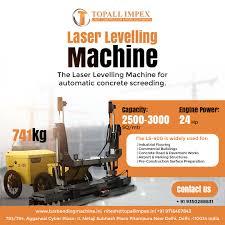In the modern construction and surveying industry, accuracy is everything. Whether you are building a skyscraper, installing tiles, or laying pipelines, precise measurements can save you time, money, and costly mistakes. This is where the Laser Level Machine comes into play—a tool designed to deliver unparalleled measurement accuracy for both large-scale and small-scale projects.
But with so many models, features, and specifications available, how do you choose the right Laser Level Machine for your needs? In this guide, we’ll break down the essential factors you should consider, along with insights from top Laser Level Machine Manufacturers and Laser Level Machine Suppliers.
1. Understand the Types of Laser Level Machines
Before making a purchase, it’s important to know the different types of Laser Level Machines and their applications:
-
Dot Laser Level – Projects one or more reference dots onto a surface, ideal for transferring points between floors.
-
Line Laser Level – Projects a horizontal or vertical line, perfect for indoor applications like tiling, carpentry, and interior design.
-
Rotary Laser Level – Projects a 360° rotating beam, suitable for large outdoor construction projects such as grading, excavation, and foundation work.
-
Combination Laser Level – Offers both line and point projection, giving versatility for multiple tasks.
Tip: If you are involved in large-scale outdoor projects, opt for a rotary laser level machine. For indoor precision tasks, a line laser level is a better choice.
2. Check the Range and Accuracy
Range refers to how far the laser beam can travel while maintaining visibility and accuracy.
-
Indoor tasks usually require a range of 10–30 meters.
-
Outdoor projects may need a range exceeding 500 meters (with a laser receiver).
Accuracy is equally important—most professional-grade Laser Level Machines offer accuracy within ±1–2 mm over 30 meters.
Advice from Laser Level Machine Manufacturers: Always check the product specifications for both range and accuracy. If your projects demand high precision, go for a model that offers a tighter accuracy margin.
3. Power Source and Battery Life
Laser level machines can be powered by rechargeable lithium-ion batteries, alkaline batteries, or direct AC power.
-
Rechargeable batteries are cost-effective and eco-friendly.
-
Replaceable alkaline batteries are convenient for long days without access to charging.
For professionals, long battery life is essential. A machine with at least 20–30 hours of continuous operation will save you from mid-project interruptions.
4. Indoor vs. Outdoor Use
Some Laser Level Machines are designed primarily for indoor applications, while others are made for rugged outdoor use.
-
Indoor use: Choose models with highly visible green beams for better clarity under artificial lighting.
-
Outdoor use: Opt for models with IP-rated waterproof and dustproof bodies, high beam power, and compatibility with a laser detector/receiver.
Pro Tip: For outdoor construction, a green laser beam is more visible than a red one, especially in bright sunlight.
5. Mounting Options and Stability
A stable base ensures accurate readings. Common mounting options include:
-
Tripod mounting – Standard for both indoor and outdoor leveling.
-
Wall mounts – Ideal for interior works like cabinetry and tiling.
-
Magnetic mounts – Convenient for working on metal surfaces.
When consulting Laser Level Machine Suppliers, ask about compatible mounting accessories to maximize versatility.
6. Durability and Build Quality
Construction sites can be tough on tools. Look for Laser Level Machines that offer:
-
Impact resistance (rubber overmolding)
-
Water and dust protection (IP54 or higher)
-
Shockproof housing
A durable machine ensures long-term value and reduces maintenance costs.
7. Self-Leveling Feature
Self-leveling Laser Level Machines automatically adjust their beams within a certain range (usually ±4°) to ensure perfect alignment. This feature eliminates human error and speeds up work.
If you choose a manual-leveling machine, you’ll need to spend extra time making adjustments, which could slow down your workflow.
8. Additional Features to Consider
Modern Laser Level Machines often come with advanced features such as:
-
Dual-axis slope function – Useful for drainage and landscaping.
-
Remote control operation – Saves time on large sites.
-
Multiple beam modes – For different project needs.
-
Pulse mode – For extended range when used with a detector.
9. Brand Reputation and Support
Always purchase from reputable Laser Level Machine Manufacturers who have a proven track record in the industry. Reliable brands not only offer high-quality products but also provide:
-
Warranty coverage
-
Technical support
-
Spare parts availability
-
Calibration services
10. Price vs. Value
While budget is important, cheaper isn’t always better. Investing in a high-quality laser level machine may cost more initially but will save you money in the long run through:
-
Better durability
-
Higher accuracy
-
Reduced downtime
Compare prices from multiple Laser Level Machine Suppliers, but always prioritize quality over cost.
Conclusion
Choosing the right Laser Level Machine is about understanding your project requirements and matching them with the right features. From the type of laser and its accuracy to durability and after-sales support, every factor plays a role in ensuring you get the most value from your investment.
By consulting trusted Laser Level Machine Manufacturers and Laser Level Machine Suppliers, you can make an informed decision and select a machine that meets both your budget and performance needs.
Whether you’re a construction professional, a surveyor, or a DIY enthusiast, the right laser level machine will not only make your work easier but also deliver results with precision and efficiency.



